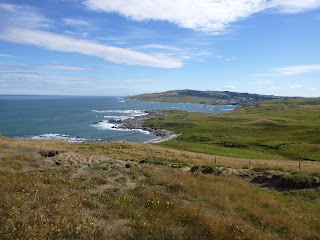 |
| Upper east end of Lake Wakatipu with less than 2 weeks to go. |
 |
| Take a big pan for these mushrooms! |
 |
| Along the Greenstone River |
 |
| Sheep farms are predominant in Southland |
 |
| The old phone booths of bygone days. |
 |
| Moss covered rock |
 |
| The excitement of finishing is building...as we have 22 km's to go along highway 1, then just another 7 km's via trail, around to Stirling Point. (Southern terminus) |
 |
| 5 more km's to Stirling Point. |
 |
| Views of Stewart Island to the south and....count them....2 km's to go! |
 |
Stirling Point at Bluff and no where to go!
All done and dusted! We've made it!!
3,054 km's (2,030 miles)
118 days to complete.
|
 |
Awesome to have
The operation on his knee, (torn cartilage), was successful.
His support from start to finish was priceless.
|
 |
Now that we have hung our boots up for the last time on this trip, it is now time to reflect…
First, I want to thank all those who encouraged and helped us, before and during the journey.
A special thanks to:
Sue Eisaguirre, and everyone involved with Nature Track in California
Kathy Gibson, and all those involved with New Zealand
Walking for causes larger than ourselves kept us going when our minds and bodies wanted to stop.
My very supportive family and friends in NZ and in the USA, (always good to hear mum’s voice on the phone)…thanks Dad and brother Beni, for meeting up with us here and there…and thanks to my other brother, Joe, for your moral support on the phone from Australia.
Thanks also to Sarn’s mum, Carol, for flying over from Australia
Most of all, to my wife Melody, who gave me two thumbs up the moment I mentioned doing this journey. Getting encouragement like that was the deciding factor. Your support and encouragement throughout was invaluable!
We met a lot of friendly and hospitable people, which always renews ones faith in mankind.
They shared their hearts and homes with us smelly, scruffy hikers.
We also met other adventurers from different parts of the globe tackling the trail. We wish them success.
The scenery and countryside of New Zealand North Island …with gorgeous coastlines and it’s rolling to rugged farmlands.
The South Island …was more dramatic and physically challenging….fewer people and more open spaces.
The Te Araroa Trail, is by far, the most physically challenging I have experienced.
There were some easy sections…but for the most part…a tough workout.
I lost 14 lbs. of body weight...my muscles shrunk over time, and now I have to get a whole new wardrobe.
I am reminded that, there is a time and place for everything. A time and a place to go, where you can reflect on life, and be inspired by the natural environment.
 |
| OK--------what next? |










